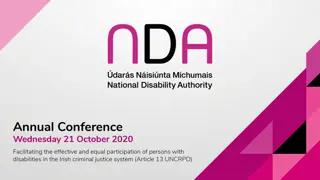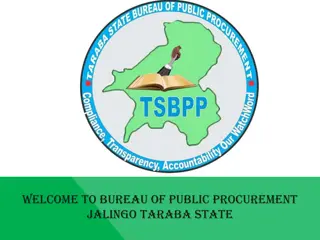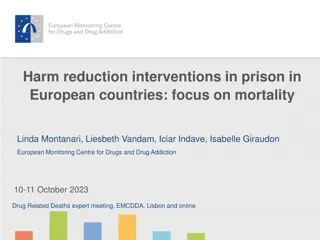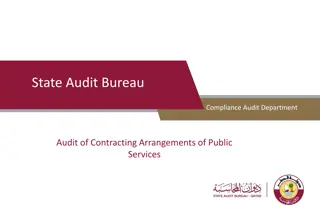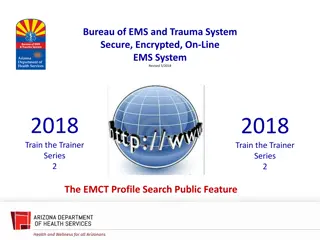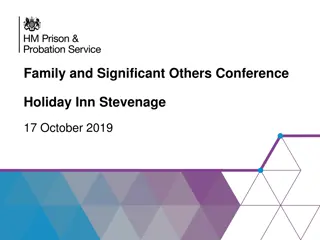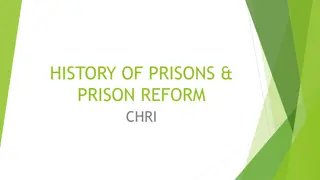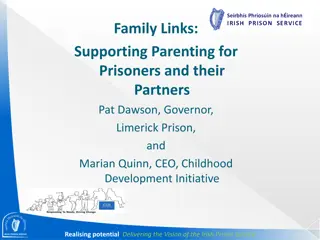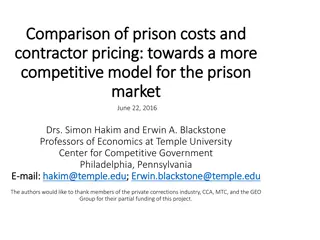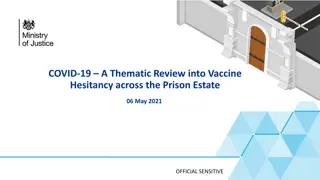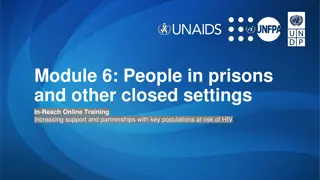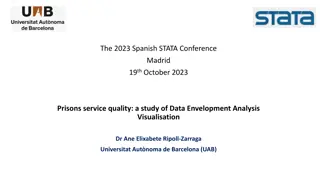The Federal Bureau of Prisons & DSCC Operations
This presentation provides insights into the Federal Bureau of Prisons' operations, focusing on the Designation and Sentence Computation Center (DSCC) in Grand Prairie, Texas. Topics include DSCC functions, initial designations, judicial recommendations, and the process from sentencing to designation within the Bureau of Prisons.
Download Presentation

Please find below an Image/Link to download the presentation.
The content on the website is provided AS IS for your information and personal use only. It may not be sold, licensed, or shared on other websites without obtaining consent from the author.If you encounter any issues during the download, it is possible that the publisher has removed the file from their server.
You are allowed to download the files provided on this website for personal or commercial use, subject to the condition that they are used lawfully. All files are the property of their respective owners.
The content on the website is provided AS IS for your information and personal use only. It may not be sold, licensed, or shared on other websites without obtaining consent from the author.
E N D
Presentation Transcript
Northern District of Indiana Continuing Legal Education May 2016 Federal Bureau of Prisons Designation & Sentence Computation Center (DSCC) Grand Prairie, Texas Presented By: Jose A. Santana, Chief, DSCC Craig Pickles, Section Chief, Sentence Computations 1
Objectives Understanding the DSCC & Its Role Initial Designations & Judicial Recommendations Sentence Calculations Other DSCC Functions 2
Federal Bureau of Prisons The Central Office & 6 Regions 3
BOP Quick Facts (As of April 28, 2016) 122 Institutions 13 Private Contract Correctional Institutions Total BOP Inmate Population: 196,134 16 Designated for Female Offenders FPC Alderson, FCI Aliceville, FPC Bryan, FMC Carswell SPC Coleman, SPC Danbury, FCI Dublin, SPC Greenville, SFF Hazelton, SPC Lexington, SPC Marianna, SPC Phoenix, FCI Tallahassee, SCP Tucson, SPC Victorville, FCI Waseca 4
Sex Offender Management Programs FMC Carswell FMC Devens FCI Elkton- Low FCI Marianna- Medium USP Marion- Medium FCI Petersburg- Medium FCI Seagoville- Low FCI Tucson - High 5
Courts of Jurisdiction Concept Work load is distributed by Courts of Jurisdiction (COJs) Each Team is assigned certain COJs For example, Tango Team handles all cases for the District of Hawaii, including probation/supervised release and parole violators. Romeo Team is comprised of: 1 - Operations Manager 5 - Classification & Computation Specialists (CCS) 6 - Classification & Computation Technician (CCT) 1 - Administrative Assistant (AA) 6
Designations & Redesignations Hotel Team is responsible for initial designations and redesignations. Hotel Team is comprised of: 1 - Operations Manager 9 - Senior Designators 7 - Designators 4 - Specialists 1 - Management Analyst 2 - Administrative Assistants 7
Process from Sentencing to Designation DSCC Team Marshals Notified of Designation Designations Team Courts Classification Staff Meeting in Progress eDesignate Probation Inmate is Scheduled for Movement Office of Medical Designations (applicable cases only) Marshals Classification Staff Arrival at Designated Facility Meeting in Progress 8
Initial Designation Process Who has Primary Jurisdiction? DSCC Team determines whether the federal government has properly acquired primary jurisdiction. Sovereign which first arrests has primary jurisdiction to complete its criminal process first, including service of sentence, unless that sovereign relinquishes custody. If the state has not properly relinquished jurisdiction, the Team notifies the USMS so they do not accept the inmate into physical custody. Jurisdiction is NOT transferred when inmate is received into federal custody via writ ad prosequendum. If the inmate is properly in federal custody, the Team will determine the custody score. 9
Initial DesignationProcess eDesignate System is used in all 95 federal judicial districts and DC Superior Court. USMS sends designation packet to responsible DSCC Team that includes the USMS Form 129, J&C, SOR and PSR. Judicial recommendations are a factor considered during the designation process. 10
Security Level Determination Program Statement 5100.08, Chapter 4 Classification is necessary to place each inmate in the most appropriate security level institution that also meets his/her program needs and is consistent with the Bureau s mission to protect society. BOP facilities are classified into Minimum, Low, Medium, High, & Administrative facilities based upon the level of security and staff supervision the institution is able to provide. Initial security designation data is entered into Sentry based upon information contained within the PSR. 11
Classification Program Statement 5100.08 Detainers/Pending Charges Pre-Commitment Status (VS = minus 3 points) Judicial Recommendations Violence History Escape History Months to Release Offense Severity Criminal History Score - (derived from the criminal history points in final judgment & SOR. If not in either document, BOP uses points assessed by USPO in PSR.) 12
Classification/ PS 5100.08 The Team uses the medical/mental health calculator to establish a screen level. The Team loads the Security Designation Data. Depending on the assigned screen level, the case is reviewed by Hotel Team (screen level 1 or 2) or by OMDT (screen level 3 or 4) for designation. 13
Initial Designation Process Upon arrival at a BOP facility. . . After initial designation and provisional care level assignment by DSCC staff, BOP clinicians determine care level based on: Treatment modalities; Inmate functionality; and Diagnostic categories (e.g., cancer, diabetes, etc.) Based on care level assessment, the institution may request a transfer from OMDT, if needed. 14
MedicalCenters (Care Level 4) FMC Butner, North Carolina FMC Carswell, Texas FMC Devens, Massachusetts FMC Lexington, Kentucky FMC Rochester, Minnesota MCFP Springfield, Missouri 15
Designation Issues Place of confinement In deciding where to designate an inmate, designators consider the custody classification level and: Inmate s care level Inmate s release residence Inmate s programming needs Population levels at appropriate institutions Recommendations of the sentencing court Central Inmate Monitoring (CIM) issues Increased security measures to ensure protection of victims/witnesses and the public 16
Initial Designation Totals 2006 - 56,581 2007 - 70,057 2008 - 68,290 2009 - 75,694 2010 - 78,037 2011 - 89,366 2012 - 80,511 2013 - 79,176 2014 - 73,454 2015 - 67,716 2016 - 17,227 (January-March) 756,109 (73,888 yearly average) 17
Redesignations 2006 - 40,633 (beginning February 2006) 2007 - 67,380 2008 - 47,391 2009 - 34,028 2010 - 37,674 2011 - 33,108 2012 - 37,466 2013 - 42,443 2014 - 52,357 2015 - 48,549 2016 - 12,670 (January-March) 453,699 (44,103 yearly average) 18
Judicial Recommendations Over the past 12 months 76% of Recommendations Followed 66,417 60,000 40,000 31,125 20,000 23,732 0 Initial Designations Judicial Recommendations Recommendations Followed/Partially Followed ** The Bureau makes every effort to comply as long as the recommendation does not conflict with Bureau policy and/or sound correctional management. 19
Judicial Recommendations Over the past 12 months For the The Northern District of Indiana 141 of 158 Judicial Recommendations Followed or Partially Followed 89% of Recommendations Followed 20
Sentencing Issues Sentencing Court Determines: The length of the prison sentence; How sentence runs in relation to other sentences, e.g., concurrent, consecutive, etc.: 18 U.S.C. 3584(a) & Setser v. United States, --- U.S.---, 132 S.Ct. 1463 (2012) Bureau Determines: Date of sentence commencement - 18 U.S.C. 3585(a) Prior custody credit - 18 U.S.C. 3585(b) Projected good conduct time - 18 U.S.C. 3624(b) Projected release date - 18 U.S.C. 3624(a) Place of incarceration - 18 U.S.C. 3621(b) 21
Sentence Calculations Updated & Assumed 2007 - 111,663 2008 - 167,571 2009 - 151,914 2010 - 168,654 2011 - 154,758 2012 - 158,736 2013 - 157,318 2014 - 153,399 2015 - 170,771 2016 - 41,140 (through 04/01) 1,435,924 (yearly average 154,976) 22
Sentence Computations-Basics When does the Sentence Commence? 18 U.S.C. 3585(a) - when defendant is received into custody at (or awaiting transport to) facility at which sentence is to be served. Prior Custody Credit - Calculated by the Bureau United States v. Wilson, 503 U.S. 329, 112 S.Ct. 1351 (1992) 18 U.S.C. 3585(b): Credit given for time in official detention (b)(1) as a result of the current offense; or (b)(2) any other offense for which defendant was arrested AFTER commission of current offense which has not been credited towards another sentence 23
Terms amended pursuant to Federal Sentencing Guidelines Amendment 782 Processed as they are received at the DSCC Calculated as if November 1, 2015 Multiple Counts/Judgments RDAP Define Release 24
Sentence Computation Good Conduct Time (GCT) 18 U.S.C. 3624(b) Available only for sentences longer than 1 year BOP awards 54 days GCT at the end of each year actually served The 54 days of GCT is equivalent to 14.79% off of a one-year and a day sentence 25
RDAP Eligibility for Early Release 18 USC 3621(e) Non-violent inmates who successfully complete the RDAP may, at the discretion of the Director, be eligible for up to a one-year early release. Must have no prior or current convictions for disqualifying offenses; Satisfactory behavior in prison; and Successful completion of all 3 components of RDAP Inmates with disqualifying convictions but documented substance abuse disorders may still participate in the program, but will not receive an early release benefit. 26
RDAP Eligibilityfor Early Release Review of Current & Prior Criminal History Reviews of all inmates entering program are conducted by DSCC Legal Staff. Current offenses reviewed under 28 C.F.R. 550.55(b)(5) and (b)(6) and PS 5162.05. Prior offenses reviewed under 28 C.F.R. 550.55(b)(4) and (b)(6). D.C. Offenders reviewed under 28 C.F.R. 550.55(a)(1)(ii). Inmates are notified of the early release determination & may appeal determinations through the Administrative Remedy Program. 27
RDAP Statistics Total # of Participants: 18,304 (FY 2015). Increasing every year; 18,102 in FY 2014. FY 2015-2016 RDAP News Spanish RDAP is expanding. The Bureau now has 2 Spanish language RDAP s. Opening of 4 additional RDAP Programs at United States Penitentiaries. New milestone reached: 700 Drug Treatment Specialists, providing residential, non-residential, and drug education services. 28
Community Confinement Residential Reentry Centers (RRC) 18 U.S.C. 3621(b): Any order, recommendation, or request by a sentencing court that a convicted person serve a term of imprisonment in a community corrections facility shall have no binding effect on the authority of the Bureau under this section to determine or change the place of imprisonment of that person. 18 U.S.C. 3624(c)(1): The Director of the Bureau shall, to the extent practicable, ensure that a prisoner serving a term of imprisonment spends a portion of the final months of that term (not to exceed 12 months), under conditions that will afford that prisoner a reasonable opportunity to adjust to and prepare for the reentry of that prisoner into the community. Such conditions may include a community correctional facility. Home Confinement (HC) - 18 U.S.C. 3624(c)(2) The authority under this subsection may be used to place a prisoner in home confinement for the shorter of 10 percent of the term of imprisonment of that prisoner or 6 months. 29
Administrative Remedy Program 28 CFR 542.10 provides an Administrative Remedy Program for inmates to seek review of an issue relating to any aspect of his/her own confinement. It is a multi-level review process which begins with an attempt at informal resolution of the issue. If that does not resolve the concern, the inmate seeks review by the Warden, then if not satisfied, review by the Regional Director. Finally, he/she may seek review by the General Counsel. 30
Administrative Remedy Program Applies to inmates in BOP institutions, in RRCs, and to former inmates regarding issues that arose during their confinement. Types of issues addressed could be, for example, sentence calculation, food/dining hall, access to religious services, housing unit assignments, visiting list concerns, disciplinary hearing officer challenges, etc. For additional information, see Program Statement 1330.16, found at www.bop.gov, under Policies. News/Information View More Information Legal Resource Guide to the Federal Bureau of Prisons 31


